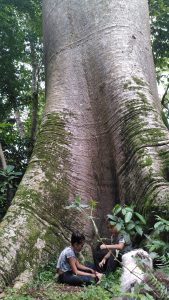In the vibrant folds of the natural world, a sensitive and passionate gaze reveals a recurring form: everything in nature is a womb. The roots of the trees intertwine in an underground dance, the caves are sculpted like stone wombs, the waves of the grandmother sea break with the force of a cosmic birth, and the puddles in the rivers take on the suggestive shape of bellies and vaginas. . . . . These sacred places, these vegetal and mineral thresholds, are not mere geographical features, but spaces designed to facilitate the constant ritualistic rebirth of the connection between human beings and nature. This phenomenon, expressed poetically in the statement “Everything in nature is a womb”, contains a profound possibility of healing, which from ecopsychology is understood as the awakening of the consciousness of being nature.

To truly understand the deep meaning of this statement, it is crucial to explore the perspective of Abadio Green (1), linguistics and wise man of the Gunadule people of Colombia. Green offers a broader vision that goes beyond a simple analogy: he argues that each person should know in detail their origins, going back generation after generation to mother, grandmother, great-grandmother, great-great-grandmother, etc., to finally remember the moment in the womb of our mother earth.

To remember the time in the womb is to immerse oneself in the very roots of existence. In that dark and warm space our essence is forged, the threads that unite us to the genetic past and the experiences of our ancestors are woven. The connection with the biological mother establishes a fundamental bond, but Abadio Green goes further by including the maternal figures of ancestral generations and the land itself. According to this perspective, each era is not just a chapter in our history, but a link in the chain of life that links us through the depths of maternal experience.

In the Gunadule worldview, this exploration expands to mother earth. Remembering the experience in her womb implies recognizing that the earth is more than a simple substrate that we walk on; It is the matrix that nourishes and sustains us. This connection is not only physical, but also spiritual. The land not only provides us with food, but also nurtures our cultural and spiritual roots.

Ecopsychology, in this context, becomes a tool for introspection and personal and collective transformation. Remaking our womb stories involves recognizing the interdependence between our existence and the natural environment. It is understanding that the earth is not just a resource, but a living organism of which we are an integral part. Every tree, every wave of the sea, every cave, every root, becomes a tangible reminder of the possibility of rebirth from Gaia.
Just as Abadio Green invites us to rebuild our earthly connections, Theodore Roszak (2), the main exponent of ecopsychology, motivates us to rebuild our relationship with the earth as a cosmic mother. The earth, in this view, is the womb of humanity, the birthplace where our individual stories intertwine with the grand narrative of life on the planet.

The metaphor of the earth as a mother and as a living womb pushes us to look beyond the earth as an exploitable resource. Instead, it invites us to see it as a living and sensitive entity, deserving of our respect and care. Roszak advocates for a deep, symbiotic connection to the land, recognizing that by returning to it, we not only regain environmental health, but also psychological and spiritual health.

The connection between the perspectives of the Gunadule people (through Abadio Green) and Ecopsychology (through Theodore Roszak) is revealed in the understanding that our return to the land is not simply an external act, but an internal process of renewal and reconnection. Reconstructing our womb stories implies, therefore, embracing the earth not only as a physical environment, but as a sacred and maternal space that gives us life and welcomes us into its bosom.
—
References:
(1) Green, A. (2011). ANMAL GAYA BURBA: ISBEYOBI DAGLEGE NANA NABGWANA BENDAGGEGALA. Significados de vida: Espejo de nuestra memoria en defensa de la Madre Tierra (Tesis Doctoral, Universidad de Antioquia). Manibinigdiginya. Directora: Dra. Zayda Sierra Restrepo.
(2) Roszak, T. (1992).The voice of the Earth. Simón y Schuster.
Photos taken by Claudio Pereira & Marian Ríos












